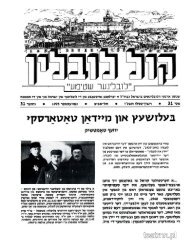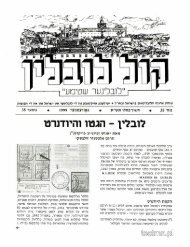The Jews in Lublin - Biblioteka Multimedialna Teatrnn.pl - Brama ...
The Jews in Lublin - Biblioteka Multimedialna Teatrnn.pl - Brama ...
The Jews in Lublin - Biblioteka Multimedialna Teatrnn.pl - Brama ...
You also want an ePaper? Increase the reach of your titles
YUMPU automatically turns print PDFs into web optimized ePapers that Google loves.
3rd November 1943, dur<strong>in</strong>g a mass execution of Jewish prisoners of all the Lubl<strong>in</strong><br />
region camps, at Majdanek concentration camp as a result of the Erntefest Operation.<br />
Under the same operation, the Janowska Street camp <strong>in</strong> Lviv was liquidated and its<br />
prisoners murdered on 19th November 1943 7 . In both cities all Jewish traces were<br />
gradually be<strong>in</strong>g erased. In Lviv this action began <strong>in</strong> 1941, i.e. with the establishment<br />
of the German occupation. First most of the synagogues were pulled down, <strong>in</strong>clud<strong>in</strong>g<br />
the Renaissance Golden Rose Synagogue <strong>in</strong> the Old Town and the Great Suburban<br />
and Tempel synagogues <strong>in</strong> Krakowskie Przedmieście Street. Additionally, both Jewish<br />
cemeteries - the Old Cemetery located at the corner of Kleparowska Street and Meisels<br />
Street, and New Cementery established <strong>in</strong> the <strong>in</strong>ter-war period <strong>in</strong> Janowska Street<br />
were destroyed. In Lubl<strong>in</strong> the demolition process began after the Podzamcze ghetto<br />
liquidation <strong>in</strong> 1942. By 1944 the whole historical centre of the Jewish town had vanished,<br />
and three Lubl<strong>in</strong> Jewish cemeteries: the Old, New and Wieniawa, were levelled.<br />
<strong>The</strong> build<strong>in</strong>gs that survived were located outside the Jewish Town (Synagogue Chewra<br />
Nosim, the Jewish Hospital, Perec House and Jesziwas Chachmej Lubl<strong>in</strong>) 8 .<br />
In Lviv the demolition of Jewish-related build<strong>in</strong>gs cont<strong>in</strong>ued also dur<strong>in</strong>g the<br />
Soviet supremacy after 1944. Due to the lack of historical sources, it is impossible<br />
now to say when precisely they were pulled down. However, we know that some preserved<br />
gravestones from the Old Cemetery were used for the construction of Len<strong>in</strong>'s<br />
monument <strong>in</strong> the Wały Hetmańskie street. <strong>The</strong> cemetery itself was altered <strong>in</strong>to use<br />
as a market <strong>pl</strong>ace - so called Krakow's Market. (It is worth mention<strong>in</strong>g that there is<br />
no commemorat<strong>in</strong>g <strong>pl</strong>aque or <strong>in</strong>formation that this <strong>pl</strong>ace used to be the oldest Lviv<br />
Jewish cemetery). <strong>The</strong> cemetery <strong>in</strong> Janowska Street has a separate Jewish section but<br />
the majority of these graves were <strong>in</strong>stalled after 1945. <strong>The</strong> nearby bushes still hide<br />
some remnants of old tombstones 9 .<br />
<strong>The</strong> ghetto liquidation entailed the demolition of the western part of Zamarstynów<br />
district, <strong>in</strong> retaliation for weak, yet exist<strong>in</strong>g, Jewish resistance <strong>in</strong> the ghetto 10 . Old<br />
7<br />
Dur<strong>in</strong>g the liquidation of the Janowska Street work camp, about 4-5,000 <strong>Jews</strong>, the last camp prisoners,<br />
were executed. However, the total number of victims is estimated at between 60,000 and 100,000<br />
peo<strong>pl</strong>e. Between 1st and 4th June 1943, dur<strong>in</strong>g the liquidation of the Lviv ghetto, the camp saw the<br />
execution of 10-12,000 <strong>Jews</strong>. Cf. KRUGLOVA., op. cit., pp. 162, 174.<br />
8<br />
<strong>The</strong> rubble of the Maharszal Synagogue (dynamited by Germans <strong>in</strong> 1942 and 1943) was still there up<br />
until the early 1960s when it was f<strong>in</strong>ally taken away.<br />
9<br />
<strong>The</strong> author managed to f<strong>in</strong>d two such gravestones. One has a name and surname of a woman <strong>in</strong><br />
Polish. <strong>The</strong> others letters are blurred. <strong>The</strong> cemetery was gradually devastated by Germans. <strong>The</strong> most<br />
beautiful gravestones — of marble and granite — were taken to Germany. <strong>The</strong>y were loaded to carriages<br />
at Kleparów railway station, the same po<strong>in</strong>t that witnessed the deportation of <strong>Jews</strong> to Bełżec. <strong>The</strong> <strong>Jews</strong><br />
of Janowska St. camp were used to this work. At the cemetery there was also a Mauritian-style funeral<br />
house. When the ghetto existed <strong>Jews</strong> suffer<strong>in</strong>g from typhoid were kept there. In August 1942 the sick<br />
were taken to the Bełżec camp or executed. This <strong>in</strong>formation is collected from an <strong>in</strong>terview with an<br />
anonymous carer at the cemetery.<br />
10 Cf. JONES E., op. cit., p. 121.<br />
66

















